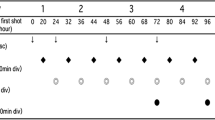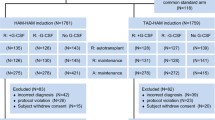Abstract
Patients with refractory or relapsed acute myeloid leukemia (AML) are often treated with regimens containing high-dose cytosine arabinoside (ARA-C), resulting in complete response rates of approximately 30% to 50%, with a median remission duration of approximately 4 months [1]. Likewise, patients with the myeloid blast crisis of chronic myeloid leukemia (CML) are often treated with high dose ARA-C, with re-establishment of a short-lived stable phase in only about 20% of cases [2]. An important reason for treatment failure in these high-risk patients is likely to be pharmacologic resistance to ARA-C, which may be due to multiple mechanisms including decreased intracellular levels of deoxycytidine kinase and decreased intracellular uptake of ARA-C. Since ARA-C is a cell-cycle-specific drug, another potential mechanism of resistance may be related to the observation that a large fraction of leukemic clonogenic cells is not in S phase at the time of ARA-C exposure [3]. We have attempted to overcome kinetic resistance to ARA-C in vitro by recruiting leukemic cells into S phase through the use of recombinant human granulocyte-macrophage colony-stimulating factor (rhGM-CSF), a humoral factor which supports the in vitro proliferation of clonogenic cells from the majority of patients with AML [4]. We have previously shown in tissue culture that this agent is able to effectively increase the fraction of leukemic clonogenic cells in S phase, and that this effect is associated with a significant increase in ARA-C-mediated cytotoxicity [5]. Since rhGM-CSF is biologically active and well-tolerated when administered to patients with normal bone marrow function [6–8], we chose to study the in vivo kinetic and therapeutic effects of combined rhGM-CSF and high dose ARA-C treatment in a population of high risk patients with myeloid leukemia. We now report the results of this treatment strategy in six patients with relapsed or refractory AML, and in two patients with the myeloid blast crisis of CML.
Supported in part by Public Health Service Grants No CA 36167, CA 42802, and CA 34183, Biomedical Research Support Grant No SO7RR05526-26, and by the U.S. Cancer Research Council.
Access this chapter
Tax calculation will be finalised at checkout
Purchases are for personal use only
Preview
Unable to display preview. Download preview PDF.
Similar content being viewed by others
References
Mayer RJ (1987) Current chemotherapeutic treatment approaches to the management of previously untreated adults with de novo acute myelogenous leukemia. Semin Oncol 14: 384–396
Iacoboni SJ, Plunkett W, Kantarjian HM, Estey E, Keating MJ, McCredie KB, Freireich EJ (1986) High dose cytosine arabinoside: treatment and cellular pharmacology of chronic myelogenous leukemia blast crisis. J Clin Oncol 4: 1079–1088
Minden MD, Till JE, McCulloch EA (1978) Proliferative state of blast cell progenitors in acute myeloblastic leukemia ( AML ). Blood 52: 592–600
Vellenga E, Ostapovicz D, O’Rourke B, Griffin JD (1987) Effects of recombinant IL-3, GM-CSF, and G-CSF on proliferation of leukemic clonogenic cells in short-term and long-term cultures. Leukemia 1: 584–589
Cannistra SA, Groshek P, Griffin JD (1989) Granulocyte-macrophage colony-stimulating factor enhances the cytotoxic’ effects of cytosine arabinoside in acute myeloblastic leukemia and in the myeloid blast crisis phase of chronic myeloid leukemia. Leukemia 3: 328–334
Devereux S, Linch DC, Costa DC, Spittle MF, Jelliffe AM (1987) Transient leucopenia induced by granulocyte-macrophage colonystimulating factor. Lancet 1: 1523–1524
Socinski MA, Cannistra SA, Sullivan R, Elias A, Antman K, Schnipper L, Griffin JD (1988) Granulocyte-macrophage colony-stimulating factor induces the expression of the CD11b surface adhesion molecule on human granulocytes in vivo. Blood 72: 691–697
Socinski MA, Cannistra SA, Elias A, Antman KH, Schnipper L, Griffin JD (1988) Granulocyte-macrophage colony stimulating factor expands the circulating haemopoietic progenitor cell compartment in man. Lancet 1: 1194–1198
Cannistra SA, DiCarlo J, Groshek P, KanakuraY, Berg D, Mayer RJ, Griffin JD (1991) Simultaneous administration of granulocyte macrophage colony stimulating factor and cytosine arabinoside for the treatment of relapsed acute myeloid leukemia. Leukemia 5: 230–238
Cannistra SA, Groshek P, Garlick R, Miller J, Griffin JD (1990) Regulation of surface expression of the granylocyte/macrophage colony-stimulating factor receptor in normal human myeloid cells. Proc Natl Acad Sei USA 87: 93–97
Andreeff M, Tafuri A, Hegewisch-Becker S (1990) Colony-stimulating factors (G-CSF, GM-CSF, IL-3, and BCGF) recruit myeloblastic and lymphoblastic leukemia cells and enhance the cytotoxic effects of cytosinearabinoside. Hamatol Bluttransfus 33: 747–762
Dolbeare F, Gratzner H, Pallavicini MG, Gray JW (1983) Flow cytometric measurement of total DNA content and incorporated bromodeoxyuridine. Proc Natl Acad Sci USA 80: 5573–5577.
Cannistra SA, Koenigsmann M, DiCarlo J, Groshek P, Griffin JD (1990) Differentiation-associated expression of two functionally distinct classes of GM-CSF receptor by human myeloid cells. J Biol Chem 265: 12656–12663
Broxmeyer HE, Cooper S, Williams DE, Hangoc G, Gutterman JU, Vadhan-Raj S (1988) Growth characteristics of marrow hematopoietic progenitor/precursor cells from patients on a phase I clinical trial with purified recombinant human granulocyte-macrophage colony-stimulating factor. Exp Hematol 16: 594–602
Leary AG, Yang YY, Clark SC, Gasson JC, Golde DW, Ogawa M (1987) Recombinant gibbon interleukin 3 supports formation of multilineage colonies and blast cell colonies in cuture: comparison with recombinant human granulocyte-macrophage colony-stimulating factor. Blood 70: 1343–1348
Lieschke GH, Maher D, Cebon J, O’Connor M. Green M, Sheridan W, Boyd A, Rallings M, Bonnem E, Metcalf D, Burgess AW, McGrath K, Fox RM, Morstyn G (1989) Effects of bacterially synthesized recombinant human granulocyte-macrophage colony-stimulating factor in patients with advanced malignancy. Ann Intern Med 110: 357–364
Bussolino F, Wang JM, Defilippi P, Turrini F, Sanavio F, Edgell CJS, Aglietta M, Arese P, Mantovani A (1989) Granulocyte-and granulocyte-macrophage-colony stimulating factors induce human endothelial cells to migrate and proliferate. Nature 337: 471–473
Herzig RH, Hines JD, Herzig GP,Wolff SN, Cassileth PA, Lazarus HM, Adelstein DJ, Brown RA, Coccia PF, Strandjord S, Mazza JJ, Fay J, Phillips GL (1987) Cerebellar toxicity with high-dose cytosine arabinoside. J Clin Oncol 5: 927–932
Muhm M, Andreeff M, Geissler K, Gorischek C, Haas O, Haimi J, Hinterberger W, Schulz G, Speiser W, Sunder-Plassmann G, Valent P, Lechner K, Bettelheim P (1989) RhGM-CSF in combination with chemotherapy — a new strategy in the therapy of acute myeloid leukemia. Blood 74: 117a
Author information
Authors and Affiliations
Editor information
Editors and Affiliations
Rights and permissions
Copyright information
© 1992 Springer-Verlag Berlin Heidelberg
About this paper
Cite this paper
Cannistra, S.A. et al. (1992). Simultaneous Administration of Granulocyte-Macrophage Colony-Stimulating Factor and Cytosine Arabinoside for the Treatment of High-Risk Myeloid Leukemia. In: Hiddemann, W., Büchner, T., Wörmann, B., Plunkett, W., Keating, M., Andreeff, M. (eds) Acute Leukemias. Haematology and Blood Transfusion / Hämatologie und Bluttransfusion, vol 34. Springer, Berlin, Heidelberg. https://doi.org/10.1007/978-3-642-76591-9_18
Download citation
DOI: https://doi.org/10.1007/978-3-642-76591-9_18
Publisher Name: Springer, Berlin, Heidelberg
Print ISBN: 978-3-540-53949-0
Online ISBN: 978-3-642-76591-9
eBook Packages: Springer Book Archive




